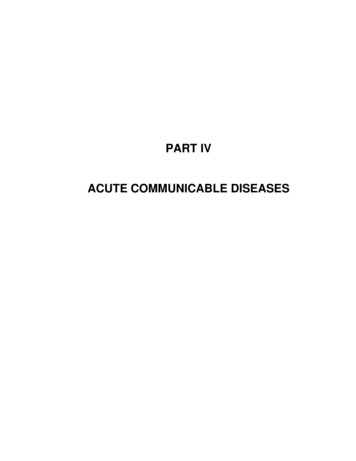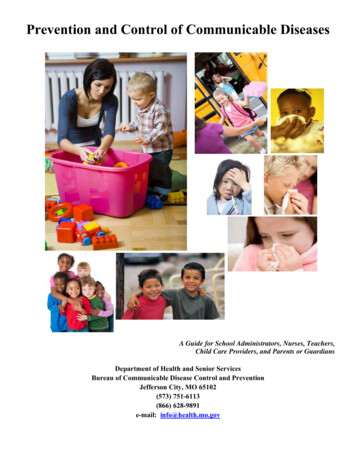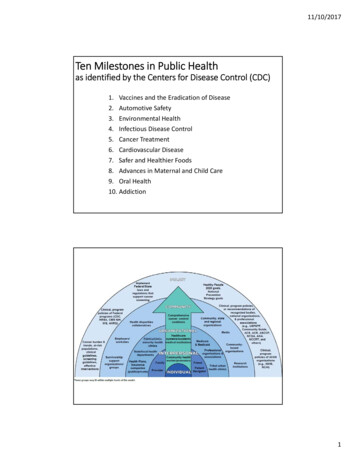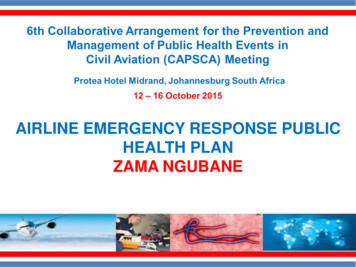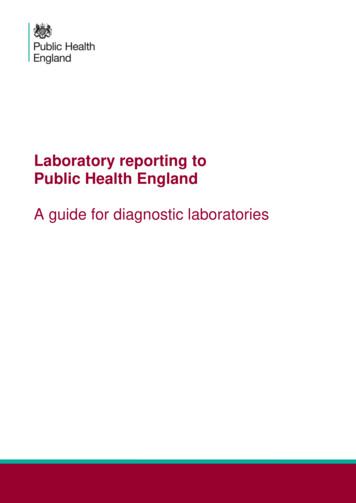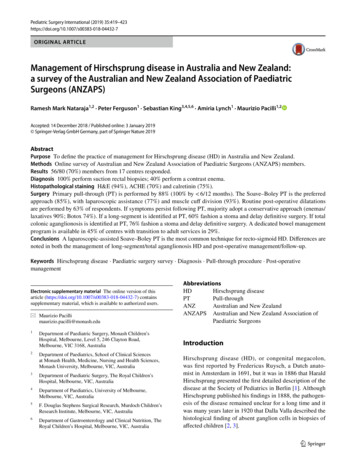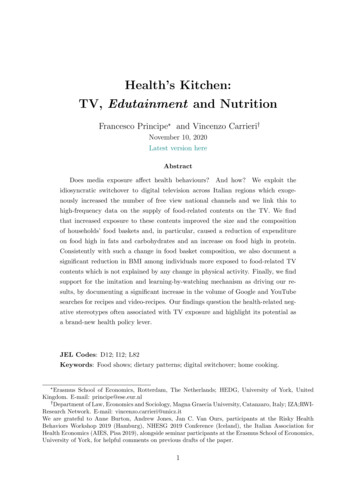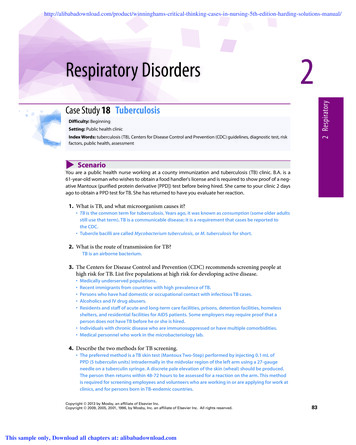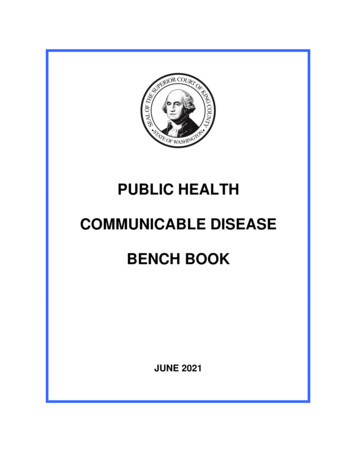
Transcription
PUBLIC HEALTHCOMMUNICABLE DISEASEBENCH BOOKJUNE 2021
Public Health Communicable Disease Bench BookACKNOWLEDGEMENTS AND ENDORSEMENTSOriginal Version (2006)The first version of this Bench Book, published in December 2006, was prepared underthe leadership of the Hon. Julie Spector of the King County Superior Court and SallyBagshaw, who was at the time Chief Civil Deputy, King County Prosecuting Attorney'sOffice. The Bench Book was drafted by a team from the Civil Division of the King CountyProsecuting Attorney's Office: Amy Eiden, Jane Ann McKenzie, Janine Joly, and SteveHobbs, with production assistance from Lisa Boggess and Megan Vogel.The authors extend sincere thanks to the Hon. Michael Trickey for his support for theoriginal project. The authors also appreciate and thank a team of reviewers of an earlydraft of the first version: Hon. Laura Inveen, Hon. Dean Lum, and Hon. Jeffrey Ramsdell.Coordinating support for the project was provided by David Reynolds, King CountySuperior Court, and Shirley Bondon, Washington State Administrative Office of theCourts. Comments and editing were provided by Joyce Roper and Kristen Mitchell,Washington State Office of the Attorney General, and Ellen Miyasato, U.S. Departmentof Health and Human Services.The authors also acknowledge Linda L. Chezem and the "Public Health Law BenchBook for Indiana Courts."The Bench Book was endorsed by the Washington State Board for JudicialAdministration and the Washington State Office of the Attorney General.Updated Version (2017)The 2017 updated version of the Bench Book was prepared under the continuedleadership of Hon. Julie Spector of the King County Superior Court. The updates for the2017 book were added by Amy Eiden and Mari Isaacson from the King CountyProsecuting Attorney’s Office and Carolyn Auchter while an intern with the King CountySuperior Court. Coordinating support was provided by David Reynolds, King CountySuperior Court, and Shannon Hinchcliffe from the Washington State AdministrativeOffice of the Courts.Updated Version (2021)This updated version of the Bench Book was prepared under the continued leadership ofthe Hon. Julie Spector of the King County Superior Court.“This bench book has been updated multiple times since its initial concept in 2005.As one of my last duties as a sitting judge, we now have the most recent version(June 2021). I want to acknowledge the research and edits made by Matt Nawrocki,who is a 2nd year law student at the University of Washington. I would also like toacknowledge Beth Taylor, who is a wizard with all things technical and making thisbench book as user-friendly as possible for those who will utilize this as weprogress through one of the worst pandemics in modern history.”Judge Julie A. SpectorPage 1
Public Health Communicable Disease Bench BookPREFACEThe original version of the Bench Book (titled “Public Health Emergency Bench Book”)was prepared in 2006, after the outbreak of Severe Acute Respiratory Syndrome(SARS), the emerging threat of pandemic influenza, and the risk of bioterrorism hadheightened awareness of the need for legal preparedness for public health emergencies.In this context, the original version focused on isolation and quarantine and otheremergency authority of State and local officials.The 2017 updated version titled “Public Health Communicable Disease Bench Book”expanded the original version to include new chapters related to tuberculosis andsexually transmitted diseases.This updated version titled “Public Health Communicable Disease Bench Book” includesupdates to the previous version. These updates reflect changes in various sections,particularly Chapters 9 and 10 regarding sexually transmitted diseases and Chapters 10and 11 regarding substantial exposure to bodily fluids. All changes reflect updates to thereferenced RCW and WAC provisions.Sexually Transmitted Diseases: There are updates to Chapters 9 and 10 regardingsexually transmitted diseases. These chapters describe the WAC and updated RCWprovisions that apply when a person with a sexually transmitted disease is engaging inconduct that endangers public health. The 2020 update to RCW 70.24.024 changes theprocedures governing health officer investigations and judicial hearings related to peoplewho are reasonably believed to be infected with or exposed to a sexually transmitteddisease.Substantial Exposure to Bodily Fluids: There are updates to Chapters 11 and 12regarding substantial exposure to bodily fluids. These chapters describe the WAC andupdated RCW provisions that apply when a certain type of employee is exposed tobodily fluids in the course of work duties in a manner that could put the employee at risk.The 2020 update to RCW 70.24.340 replaces references to “HIV” with “blood-bornepathogens.” It also replaces “substantial exposure” with “exposure” in severalreferences.We hope that this Bench Book is a useful educational tool for the Court to use forproceedings related to the spread of communicable disease.June 2021Page 2
Public Health Communicable Disease Bench BookTABLE OF CONTENTSSUMMARY AND CHECKLISTSummaryIsolation and Quarantine Checklist1.00JURISDICTION, VENUE, AND RELEVANT CIVIL 02.00EMERGENCIES AND EMERGENCY viewConditions of EmergencyState Organization and AuthorityState OrganizationAuthority of the GovernorLocal Organization and AuthorityLocal OrganizationLocal AuthorityHEALTH AGENCIES AND BOARDS3.103.203.303.403.413.423.503.603.70Federal v. StateThe United States Constitution and Public HealthStates as Primary ActorsState and Local Venue DeterminationsCourts of JurisdictionVenueWrits of Habeas Corpus and Personal Restraint PetitionsStatutory Writs of Mandamus and ProhibitionWrit of MandamusWrit of ProhibitionApplicability of Local Rules of Court to Public Health CasesOverviewWashington State Board of HealthWashington State Department of HealthLocal Health Boards, Departments, and OfficersStructurePowers and Duties Related to Communicable Disease ControlViolations and PenaltiesHealth DistrictsRelationship between State and Local Health DepartmentsPage 3
Public Health Communicable Disease Bench Book4.00COMMUNICABLE DISEASE ewCommunicable Disease Reporting and InvestigationCommunicable Disease ReportingCommunicable Disease InvestigationConfidentialityFederal and State Laws Protecting Health Care InformationDisclosures Related to Communicable Disease ControlPublic Records ActCOMMUNICABLE DISEASE 25.436.00OverviewSocial Distancing MeasuresIsolation and QuarantineIsolation and Quarantine ProceedingsIsolation and Quarantine Conditions and PrinciplesSample Local Health Officer Emergency Detention OrderFederal AuthoritySummary of State and Federal Authority for Isolation and QuarantineAnimal HealthWashington State Department of AgricultureWashington State Department of HealthFederal AuthoritySAMPLE PLEADINGS FOR ISOLATION AND 6.236.306.316.326.33Pleadings for Involuntary Isolation or QuarantinePetition Ex-Parte for Involuntary Isolation or QuarantineDeclaration of Disease Control Officer in Support of PetitionStatement of Rights of Respondent and Notification of Attorney[Proposed] Order for Involuntary Isolation or QuarantineSummonsDeclaration of ServicePleadings for Order to Close Hearings and Seal RecordsMotion for Order to Close Hearings and Seal RecordsSealed Data Form (Sealed Record)[Proposed] Order to Close Hearings and Seal RecordsPleadings for Continued Isolation or QuarantinePetition for Continued Isolation or QuarantineDeclaration of Compliance with WAC 246-100-045[Proposed] Order for Continued Isolation or QuarantinePage 4
Public Health Communicable Disease Bench Book7.00TUBERCULOSIS iewInvoluntary Detention for Examination, Testing and TreatmentInvoluntary Detention ProceduresSample Local Health Officer Emergency Detention OrderSAMPLE PLEADINGS FOR TUBERCULOSIS CONTROLPleadings for Emergency DetentionPetition Ex Parte for Emergency DetentionDeclaration of Disease Control Officer in Support of PetitionStatement of Rights and Notification of Attorney[Proposed] Order for Emergency DetentionSummonsDeclaration of ServicePleadings for Order to Close Hearings and Seal RecordsMotion for Order to Close Hearings and Seal RecordsSealed Data[Proposed] Order to Close Hearings and Seal RecordsPleadings for Continued Detention or Other MeasuresPetition for Detention or Other Measures[Proposed] Order for Detention or Other MeasuresSEXUALLY TRANSMITTED DISEASES – CONDUCT ENDANGERINGPUBLIC HEALTHHealth Officer AuthorityJudicial HearingsSAMPLE PLEADINGS FOR SEXUALLY TRANSMITTED DISEASES –CONDUCT ENDANGERING PUBLIC HEALTHPetition for Order to Show CauseDeclaration in Support of Petition for Order to Show CauseMotion for Order to Close Hearings and Seal RecordsSample Sealed Data Form[Proposed] Order to Close Hearings and Seal Records[Proposed] Order to Show CauseSUBSTANTIAL EXPOSURE TO BODILY FLUIDSDefinitionsHealth Officer and Judicial ProceduresPage 5
Public Health Communicable Disease Bench AMPLE PLEADINGS FOR SUBSTANTIAL EXPOSURE TO BODILYFLUIDSPetition for Order to Show Cause and for Order Authorizing Blood-bornePathogen TestingDeclaration of Exposed PersonDeclaration of Disease Intervention SpecialistMotion for Order to Close Hearings and Seal RecordsSealed Data Form[Proposed] Order to Close Hearings and Seal Records[Proposed] Order to Show CauseOPERATION OF THE COURTS AMID PUBLIC HEALTH THREATSAppearance of Individuals Posing a Potential Threat to Public HealthAppearance by Means Other Than in PersonClosure of Hearings or Sealing of RecordsProtection of Court PersonnelRelocation of CourtProceedings Involving Numerous PersonsAdditional Judicial PersonnelConsolidation of CasesEmergency Court ClosurePresiding Judge in Superior Court District and Limited JurisdictionCourt DistrictAppendix A – King County Code and Seattle Municipal Code ProvisionsKing County Code ProvisionsSeattle Municipal Code ProvisionsPage 6
Public Health Communicable Disease Bench BookSUMMARYJURISDICTION, VENUE, AND RELEVANT CIVIL ACTIONS (Chapter 1.00)The U.S. Constitution (1.11) Federal government's public health powers limited to those that fallwithin its jurisdiction (defense, interstate commerce, tax powers). Responsibility for safeguarding public health in other areas fallslargely to the states. Federal government has responsibility for public health in somediscrete geographic areas such as military bases. Pursuant to its itemized powers, federal government may exercise somepublic health functions such as those granted to the U.S. Department ofHealth and Human Services or those related to public healthemergencies precipitated by acts of war or terrorism.States as Primary Actors (1.12) The state's public health authority comes from its police powers. The Washington Constitution established the State Board of Healthwith powers set forth by the legislature. The Washington Constitution gives local governments power to makeand enforce police, sanitary and other regulations not in conflict withgeneral laws.Jurisdiction Over Public Health Matters (1.21) Superior courts have original jurisdiction. The Court of Appeals and the Supreme Court have appellatejurisdiction.Venue for Public Health Matters (1.22) Proper venue is in the superior court of the county at issue orThurston County Superior Court. Venue may be changed as provided in statute and court rule.Petitions for Writs of Habeas Corpus (1.30.A) Governed by chapter 7.36 RCW. May be granted by the Supreme Court, Court of Appeals, or SuperiorCourt. Any person "restrained of his liberty under any pretense whatever,may prosecute a writ of habeas corpus." Writ must be signed, verified and contain information set out instatute. Writ requires officer restraining individual to produce the individualwithout delay at the time and place directed by the judge. To prevail, habeas petitioner must show actual prejudice resultingfrom constitutional error.Personal Restraint Petitions (1.30.B) Governed by chapter 10.73 RCW and RAP 16.3 to 16.15, 16.24 to16.27. Court of Appeals and Supreme Court have concurrent jurisdiction.Cases filed in Superior Court should be transferred to the Court ofReturn to TOCPage 7
Public Health Communicable Disease Bench BookAppeals for lack of Superior Court jurisdiction. Mandatory elements for petition set out in RAP 16.7. If responding party is the government, the petition should be captionedonly with the name of the petitioner, and the governmental agency orperson responsible for the proceeding claimed to be improper shallrespond. To prevail, petitioner must show either (1) constitutional error thatcaused substantial actual prejudice, or (2) nonconstitutional error thatresulted in a fundamental defect constituting a complete miscarriage ofjustice.Statutory Writs of Mandamus and Prohibition (1.40) Writ of mandamus compels the performance of an act. Writ of prohibition arrests the proceedings of any tribunal, corporation,board, or person.Applicability of King County Rules of Court to Public Health Cases (1.50) As a general rule, public health cases are conducted in same manner asother proceedings.EMERGENCY AND EMERGENCY MANAGEMENT (Chapter 2.00)Emergency Defined (2.20) "Emergency" defined in RCW 38.52.010(9)(a).State Organization (2.31) State Military Department shall administer emergency managementprogram of the state. Adjutant General is the Director of the Military Department and isresponsible to Governor for carrying out program for emergencymanagement.Authority of the Governor (2.32) Governor may find existence of emergency pursuant toRCW 43.06.010(12). Emergency powers only effective within area described in Governor'sproclamation. Procedural requirements for proclamation set out in RCW 43.06.210. Governor issues proclamation to terminate state of emergency andmust do so when order has been restored in the area affected. After proclaiming state of emergency, Governor may issue orders asprovided in RCW 43.06.220. In the event of a disaster beyond local control, the Governor mayassume control over all or any part of emergency functions of thestate.Governor authorized to: Make, amend, and rescind necessary orders, rules and regulations Enter into mutual aid agreements Coordinate mutual aid interlocal arrangements Delegate administrative authorityReturn to TOCPage 8
Public Health Communicable Disease Bench Book Cooperate with federal officials and officers and agencies from otherstatesDuty of every organization for emergency management to enforceGovernor's orders.Criminal sanctions as provided in chapter 43.06 RCW apply during anemergency.In case of removal, resignation, death, or disability of the Governor,duties devolve upon the following, in order: Lieutenant Governor,Secretary of State, Treasurer, Auditor, Attorney General,Superintendent of Public Instruction, Commissioner of Public Lands.Case law involving actions by the Governor during an emergency: Clear intent by the Legislature to delegate requisite police power tothe Governor in times of emergency Governor has discretion to determine both the start and end of anemergencyLocal Organization (2.41) Each local organization for emergency management shall: (1) performemergency management functions within its jurisdiction, and (2) conductsuch functions outside as may be required. Emergency management director shall have direct responsibility for thelocal organization, subject to direction and control of the executive officer.Local Authority (2.42) May exercise statutory emergency management powers in light of theexigencies of an extreme emergency situation without regard toprocedures and formalities. Will have the power to enter into contracts and incur obligationsnecessary to combat disaster, protect health and safety of personsand property, and provide emergency assistance. Directed to use existing services, equipment, supplies, and facilities.Officers and personnel required to cooperate notwithstanding otherprovisions of law. Services and equipment may be commandeered by Governor, executive,and emergency management director after proclamation by Governor ofemergency.HEALTH AGENCIES AND BOARDS (Chapter 3.00)Washington State Board of Health (3.20) Powers and Duties Related to Communicable Disease Control Rulemaking Enforcement of State Board of Health RulesWashington State Department of Health (3.30) Powers and Duties Related to Communicable Disease Control Enforcement of laws and rules Investigation of outbreaks of disease Investigation of conditions that threaten public healthReturn to TOCPage 9
Public Health Communicable Disease Bench BookLocal Health Boards, Departments, and Officers (3.40) Structure Local Board of Health Membership Jurisdiction coextensive with county boundaries Local Health Departments County or district Combined city-county health department Local Health Officer Powers and Duties Related to Communicable Disease Control Local Boards of Health Rulemaking for the public health Enforcement of state public health statutes and rules Supervisionof health and sanitary measures Provide for control and prevention of contagious disease Local Health Officers Enforce state and local laws, including filing of civil actionsMaintain health and sanitation supervision Control and prevent spread of contagious diseaseInvestigate diseases and institute control measures Controldisease at schools and day care centers, including shutdown, in certain circumstances, and after appropriatenotification Report and track communicable diseasesImplement isolation and quarantine Case law involving authority of local board of health and healthofficers Law and actions are to be liberally construed Local regulations may not conflict with state or federal lawViolations and Penalties (3.50) Misdemeanor for person to violate rule or order of local health officer orlocal or State Board of health. Public officers and employees can be fined for failing to enforce rulesadopted by State Board of Health. Members of local boards of health can be fined for failing to enforce rulesadopted by State Board of Health for the control of dangerous infectiousdisease. Local health officer who refuses or neglects to enforce the provisions ofchapters 70.05 or 70.24 RCW, or rules of State Board of Health can beremoved.Health Districts (3.60) Establishment Is all the territory consisting of one or more counties. If two or more counties, created by the county commissioners.Return to TOCPage 10
Public Health Communicable Disease Bench Book If one county, created by county legislative authority.District Boards of Health At least five members for districts of two counties, and sevenmembers for districts of more than two counties County commissioners provide for membership on the boards If health district is one county, county legislative authority specifiesmembership.Relationship between State and Local Health Departments (3.70) State Board of Health rules to be enforced by local boards of healthand local health officers Secretary of Health can enforce state public health laws and regulationsin local matters when an emergency exists or the local board of healthhas failed to act with sufficient promptness, or no local board of healthhas been established. Secretary of Health can exercise authority of local health officer whenneeded due to an emergency, the local health officer has failed to act, orpursuant to agreement.COMMUNICABLE DISEASE TRACKING (Chapter 4.00)Communicable Disease Reporting (4.21) Reportable Diseases State regulations require certain persons to report “notifiableconditions” that are those diseases or conditions of public healthimportance. Diseases of suspected bioterrorism origin are to be reportedimmediately. Examples: Anthrax and smallpox. Other rare diseases of public health significance are to bereported immediately. Unexplained critical illness or death is to be reported immediately. Local health officer can require notification of additional conditions ofpublic health importance. Outbreaks or suspected outbreaks are reportable, even if thedisease is not identified as a notifiable condition.Persons and entities having a duty to report: health care providers;laboratories; health care facilities. Records and specimens containing or accompanied by patient identifyinginformation are confidential. Local health officers and State Department ofHealth to maintain confidentiality. (Permissible disclosures discussed at§ 4.32.) Other persons and entities with responsibilities related to reporting:veterinarians (to State Department of Health and to State Department ofAgriculture); food service establishments; child day care facilities;schools.Federal regulations identify select agents and toxins that have thepotential to pose a severe threat to public health and safety and establishrequirements for security, training, biosafety, and incident response. Return to TOCPage 11
Public Health Communicable Disease Bench BookCommunicable Disease Investigation (4.22) Duties of local health officer Review and determine appropriate action. Conduct investigations and institute control measures. Notify state Department of Health of notifiable condition uponcompletion of case investigation. Authority of local health officer Carry out additional steps to verify diagnosis reported by healthcare provider. Require person suspected of having reportable disease to beexamined. Investigate case or suspected case of reportable disease, ifnecessary. Require notification of additional conditions of public healthimportance. Duties of state Department of Health related to investigation. Provide consultation and technical assistance to local healthdepartments when requested. Conduct investigations and institute control measures asnecessary.Confidentiality (4.30) Federal and State Law Protecting Health Care Information Federal: HIPAA (45 CFR pts. 160, 164). General Rule: Covered entity(health plan, health care clearinghouse, and health care providerswho transmit certain transactions electronically) may not use ordisclose protected health care information except as permitted byHIPAA. If a covered entity is a public health authority, it may useprotected health information for certain public health activities.Preempts less stringent state laws. State: HCIA (chapter 70.02 RCW). General rule: Health careproviders and health care facilities may not disclose health careinformation without a patient’s written authorization, except asauthorized by RCW 70.02.050. State and local agencies obtaininginformation pursuant to RCW 70.02.050 are to establish recordacquisition, retention, destruction, and security policies consistentwith HCIA.Disclosures Related to Communicable Disease Control Return to TOCDisclosures permitted by HIPAA Disclosures otherwise authorized by law. Disclosures for public health activities. Disclosures to avert a threat to health and safety.Disclosures permitted by HCIA To federal, state, or local public health authorities to the extentrequired by law. To federal, state, or local public health authorities whenneeded to protect the public health. To avoid or minimize an imminent danger.Page 12
Public Health Communicable Disease Bench Book Disclosures by local and state health departments Local and state Health Department not to disclose reportinformation identifying an individual case or suspected caseexcept to:o Employees or other officials needing to know foradministering public health laws and regulations in chapter246-101 WAC;o Health care providers and others for the purpose ofcollecting additional information about a case or suspectedcase, as required for disease control.Public Records Act PRA provides that HCIA applies to inspection and copying ofhealth care information of patients.PRA permits third parties affected by requests to be notified.COMMUNICABLE DISEASE CONTROL (Chapter 5.00)Social Distancing Measures (5.20) Intended to decrease spread of disease of decreasing opportunities forclose contact among individuals. Examples: Closing schools and large child care centers. Limiting social interaction at various facilities. Closing churches, theaters, and other places where crowdsgather. Suspending large gatherings, such as sports events and concerts. Suspending non-essential government activity.Implementation may be voluntary or compulsory.Authorities: Heads of political subdivisions in response to emergency. (See §2.42.) Local health officer to prevent spread of disease. (See § 3.42.B.) Governor in response to an emergency. (See § 2.32.B.)Isolation and Quarantine (5.30; 5.31) Form of social distancing Under rules adopted by State Board of Health, local health officer hasauthority to implement isolation and quarantine. Applies to person orgroup of persons.Local health officer can initiate emergency detention by issuingemergency detention order or by petitioning the superior court ex parte.Local health officer may initiate emergency detention when (s)he: Return to TOCHas made reasonable efforts to gain voluntary compliance withrequests for medical examination, testing, treatment, counseling,vaccination, decontamination of persons or animals, isolation,quarantine, and inspection and closure of facilities, or hasdetermined that seeking voluntary compliance would create a risk ofserious harm; andHas reason to believe that the person or group of persons is, or isPage 13
Public Health Communicable Disease Bench Booksuspected to be, infected with, exposed to, or contaminated with acommunicable disease or chemical, biological, or radiological agentthat could spread to or contaminate others if remedial action is nottaken; and Has reason to believe that the person or group of persons wouldpose a serious and imminent risk to the health and safety of othersif not detained for purposes of isolation or quarantine.Local Health Officer Emergency Detention Order Local health officer shall issue written emergency detention order as soonas reasonably possible and always within twelve hours of detention, withcopies to persons, by posting in some cases. An order issued by a local health officer shall constitute the dulyauthorized application of lawful rules adopted by the State Board ofHealth and must be enforced by all police officers, sheriffs, constables,and all other officers and employees of any political subdivisions withinthe jurisdiction of the health department in accordance with RCW43.20.050. No explicit authority for arrest by law enforcement, though seeRCW 10.31.100(1).Court proceedings for emergency detention(see Isolation and Quarantine Checklist) The local health officer may petition the superior court ex parte for anorder authorizing involuntary detention of a person or group of persons forup to ten (10) days. The court shall issue the order if there is a reasonable basis to find thatisolation or quarantine is necessary to prevent a serious and imminentrisk to the health and safety of others.Court proceedings for continued detention(see Isolation and Quarantine Checklist) The local health officer may petition the superior court for an orderauthorizing continued detention of a person or group of persons for up tothirty (30) days. The court shall grant the petition if it finds that there is clear, cogent, andconvincing evidence that isolation or quarantine is necessary to prevent aserious and imminent risk to the health and safety of others.Court proceedings for an additional period of continued detention(see Isolation and Quarantine Checklist) Prior to the expiration of a court order for continued detention, the localhealth officer may petition the superior court for an order to continueisolation or quarantine for up to an additional thirty (30) days. Isolation or quarantine may be continued when the court finds that thereis a reasonable basis to require continued isolation or quarantine toprevent a serious and imminent risk to the health and safety of others.Statutes and rules that supersede The provisions of WAC 246-100-040 shall be superseded by statestatutes and rules, and state and federal emergency declarations thatcontain procedures for detention, examination, counseling, testing,treatment, vaccination, isolation, or quarantine for:Return to TOCPage 14
Public Health Communicable Disease Bench Book Specified health emergencies; orSpecified communicable diseases, including, but not limited to,tuberculosis and HIV.Right to representation A person or group of persons isolated or quarantined has a right to berepresented by counsel. If a person or group requests counsel and cannot afford counsel, thecourt shall appoint counsel consistent with the provisions of chapter10.101 RCW. The local health officer must provide adequate means ofcommunication between persons or groups and their counsel.Relief from isolation or quarantine A person or group of persons detained by order of the local health officermay apply to the court for an order to show cause why the individual orgroup should not be released. The court shall rule on the application toshow cause within forty-eight (48) hours of its filing. If the court grantsthe application, the court shall schedule a hearing on the order to showcause as soon as practicable. The issuance of an order to show causeshall not stay or enjoin an isolation or quarantine order. A person or group isolated or quarantined may request a hearing forremedies
Appendix A – King County Code and Seattle Municipal Code Provisions . Return to TOC Page 7 Public Health Communicable Disease Bench Book SUMMARY JURISDICTION, VENUE, AND RELEVANT
